Tea Cakes and Tarts
Exhibits and Outreach Internship, 2022
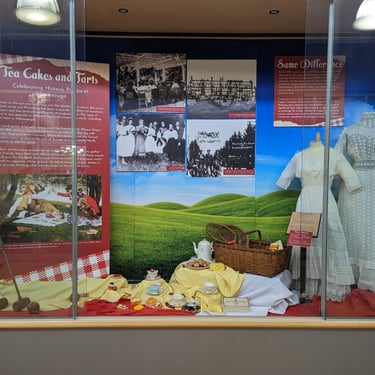

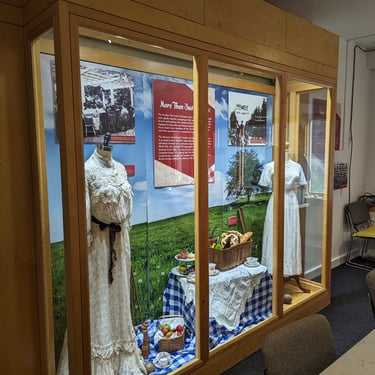
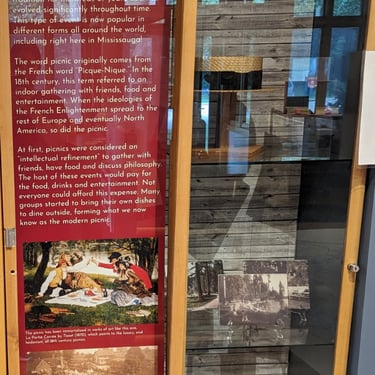
I created this exhibit while working as an exhibits and outreach intern at the Museums of Mississauga. I did the research, image sourcing and design for the exhibit with curation notes on which artifacts should be on display. The timeline between the completion of my internship and the installation of the exhibit meant that I couldn't be there for the final install or selection of artifacts, which made it all the more exciting to see images of the final product.
This mini exhibit explored the time-honoured tradition of picnics in the Mississauga area. I was able to use archival images from the Benares Family collection to not only point out the leisurely aspects but the work the Benares women did to raise money for the First World War - by hosting picnics!
Overall, I enjoyed producing this exhibit and working on the research and design elements. It highlighted a number of images and artifacts from the collection and highlighted a unique aspect of Mississauga history.
Photos by Megan Wiles
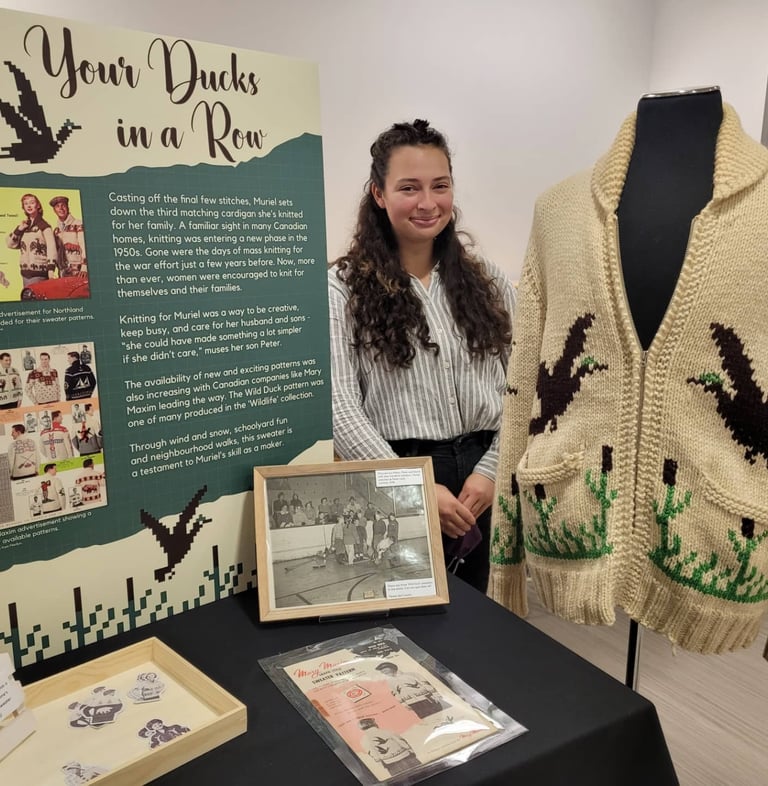

Get Your Ducks in a Row: A Mini Exhibit Project
Museum Management and Curatorship, 2021-2022

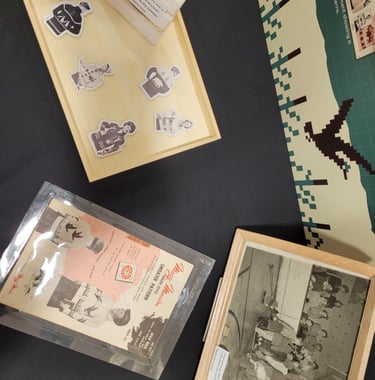
The completed mini exhibit. December 2021.
Top down view of the table contents. Take home stickers, the original knitting pattern and a contextual image.
The mini-exhibit project was a multi-step process that lead to a final project I loved, as well as the recipient of Curators Choice. The first step was to research the "artifact" in question, a 1957 Mary Maxim sweater knit by my grandmother. The 18-page document became the basis for the interpretive text on the panel, condensed to 147 words. I designed the panel to reflect some of the elements in the original knitting pattern, which was displayed alongside the panel and sweater. I displayed a contextual image of my grandfather, uncle and father all wearing their sweaters (my grandmother knit three matching ones) at a curling game in 1958. The interactive element was a take home sticker. Mary Maxim created their graphic sweaters to be able to appeal to everyone's interests - everyone should be able to see themselves in a Mary Maxim sweater. I used original images of these sweaters and turned them into sticker versions so visitors would be able to take home their sweater, albeit in miniature form.
The process was very rewarding, but I am most proud of the cohesiveness in design as well as the research paper. The history of knitting in Canada isn't as well documented as in other places around the world, notably the UK. Researching Mary Maxim as well as knitting trends in the 1950s not only helped to situate the sweater in a broader historical and Canadian context, but it also enabled me to do more research into an area I find interesting. Being a knitter myself was also a significant motivation to do as much in-depth research in this area as I could.
Home and Away: Interactives
Museum Management and Curatorship, 2021-2022
In order to have a well-rounded exhibit, the class was split into teams to achieve a number of tasks. I was part of the Interactives team, where we created a variety of physical and virtual interactives to complement the exhibit. The initial planning stage involved gathering ideas from the class and linking them to the themes presented in the exhibit. After refining the list we planned out how to achieve the seven interactives we created.
Once we finalized the ideas we were able to start creating our interactives. We have a fairly balanced set of interactives, with about half being digital. Below you can see the construction of our activity booklet, done in partnership with the Graphic Design team.
The final interactive offerings included an exhibit wide activity handbook with collectible stickers, an interactive map, a travel playlist, history pin, AV content about space travel, a photo-op station, a "cabinet of curiosities" guessing game and a station to plan a Staycation in the Peterborough area.
Our exhibit travel-themed playlist can be found here. Our HistoryPin of Peterborough Landmarks can be found here.
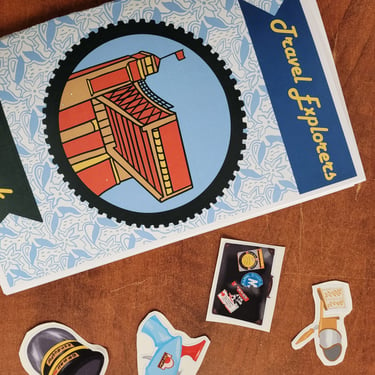
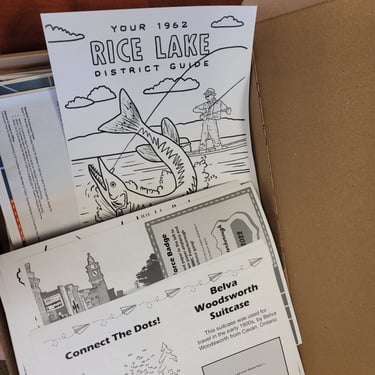
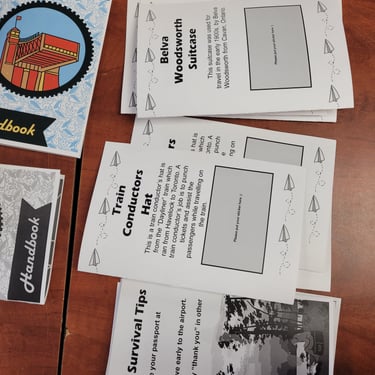
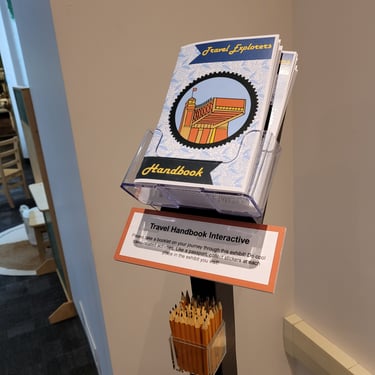

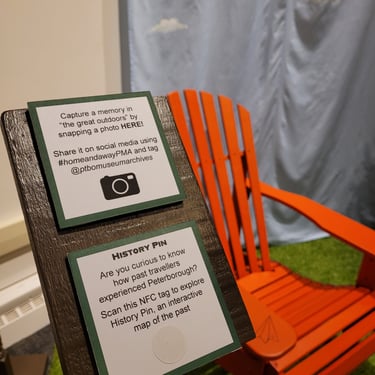
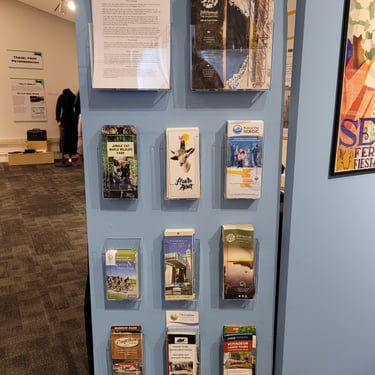

Home and Away: Install Week
Museum Management and Curatorship, 2021-2022
In addition to working in my interactives team, the weeks leading up to our exhibit installation also required the class to break into different tasks for artifact handling, fabrication, painting and more. During this week I had the opportunity to work on a variety of painting projects (space dividers, stanchions, and adding varathane to a wooden bench), creating brown paper mockups, editing an AV interactive, preparing the exhibit booklets and proof reading and editing exhibit text.
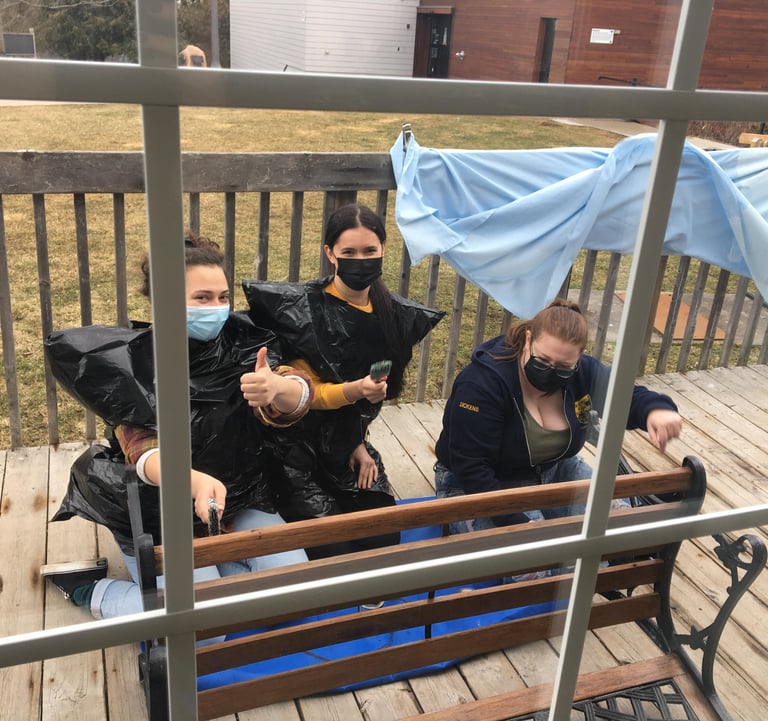

Adding varathane to this wooden bench to pretty it up for the exhibit. Having seating in an exhibit is important, and can be cute too!
Together, these additional tasks ensured that the exhibit would be ready to go up in an efficient and timely manner during exhibit install week. After four days and a number of smaller tasks the exhibit went up for soft launch. In the first week we received some very helpful feedback from the Peterborough Museum and Archives (the museum hosting the exhibit and our partner site). The NFC tags that linked to our virtual content wasn't working as smoothly as we had hoped and we needed garbage cans for the sticker backs. After addressing those concerns, the final element that we needed to do tied back to my work with the Interactives team. We created a "legacy" parcel for the museum, with digital files and physical copies of our interactives materials. This allows the museum to refill the interactives stations as needed once the class disperses for the summer.
Home and Away: Virtual Exhibit
Museum Management and Curatorship, 2021-2022
The final component of our exhibit project was creating a virtual companion exhibit. With a team of seven students, our plan was to create online exhibit content through Omeka (a virtual exhibit platform) as well as create a video exhibit tour for the website, to be hosted on the Peterborough Museum and Archives (PMA) YouTube channel. I worked on the video project, and "guided" viewers through some of our exhibit highlights. Once the video is complete, we will use captioning software to provide the PMA with a caption file to include in the video for accessibility. Working on a virtual component to our exhibit increases the longevity of our work, and research, and improves accessibility to this content.
